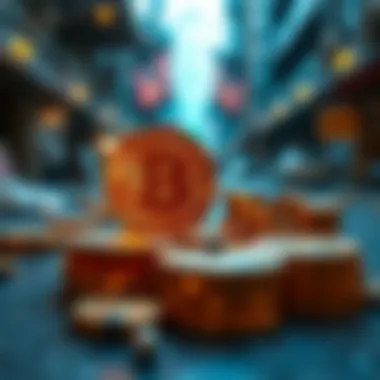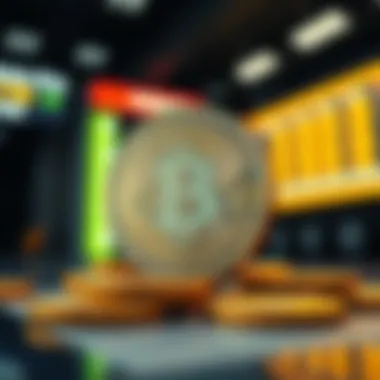Understanding NFTs and Cryptocurrency: Insights and Impacts


Intro
The digital landscape is ever-evolving, and at its forefront are non-fungible tokens (NFTs) paired with the revolutionary progress of cryptocurrency. Despite their rise to fame being relatively recent, these two concepts have become inseparable, capturing the fascination of a myriad of individuals and industries. NFTs have stirred up conversations about digital ownership, art, culture, and rights, whereas cryptocurrencies offer an alternative financial ecosystem that challenges traditional norms. It's essential to unpack these connections to fully grasp their implications.
Understanding the intricacies of NFTs and cryptocurrencies opens doors to various sectors. From artists exploiting new revenue streams to gamers decorating their digital worlds with unique assets, the utility of NFTs transcends far beyond art galleries. Cryptocurrencies, initially seen as just a medium of exchange, now herald a broader systemic transformation in finance and asset ownership. Educators, analysts, traders, and tech enthusiasts each have valid reasons to delve into these interconnected realms.
As we embark on this exploration, it becomes paramount to examine the market dynamics in which these digital assets exist. Analyzing current trends provides insights into user behavior and economic patterns, which inform both investment strategies and broader social implications. The following sections will dissect these topics in detail, aiming to clarify these complex subjects for readers ranging from beginners to seasoned investors.
Preface to NFTs and Cryptocurrency
In recent years, the intersection of non-fungible tokens (NFTs) and cryptocurrency has garnered much attention, reshaping the landscape of digital ownership and financial transactions. The significance of understanding these concepts extends beyond mere curiosity; they represent a substantial shift in how individuals view value, art, and even identity in the digital space.
Recognizing the nuances of NFTs and cryptocurrency allows for a deeper appreciation of their implications. As the world pivots towards a more digital-first approach, these technologies offer solutions and opportunities previously unimagined. From artists monetizing their work online to gamers owning virtual assets, the applications are vast and varied.
Moreover, the discussion of NFTs often intertwines with the characteristics of cryptocurrency, showcasing their combined effect on commerce and innovation. It's vital to grasp these intertwined relationships, as they will certainly shape many sectors going forward.
This introduction serves to lay the groundwork, paving the way for more intricate discussions in the following sections. Readers should anticipate not only a definition of NFTs and their functioning but also a broader perspective on how cryptocurrency plays a crucial role in this digital revolution.
"The essence of NFTs is the creation of digital scarcity, which transforms our understanding of ownership in the virtual world."
Defining Non-Fungible Tokens
To understand NFTs, one first needs to recognize the term "non-fungible." Unlike currency, which is fungible—meaning each unit is interchangeable—NFTs are unique digital assets. They can represent various forms of media: digital art, music, virtual real estate, and even tweets. When someone purchases an NFT, they aren’t simply buying a file; they are securing ownership of a verifiable token on a blockchain, which confers authenticity and uniqueness.
This uniqueness becomes a double-edged sword. On one side, it grants collectors the thrill of owning rare items. On the other, it raises questions about the value of digital goods compared to traditional assets. Questions like, "What is the true worth of a digital artwork?" linger in the air, highlighting a perplexing aspect that investors grapple with.
The Role of Cryptocurrency in Digital Transactions
Cryptocurrency functions as the underlying currency for many NFT transactions, transforming how payments are made in the digital realm. Unlike traditional currencies backed by physical commodities, cryptocurrencies like Ethereum play a pivotal role by providing a decentralized and secure means for buyers and sellers to exchange value.
When purchasing NFTs, buyers usually use cryptocurrencies. This method has proven beneficial due to several aspects:
- Decentralization: Eliminates the need for intermediaries, thus reducing transaction fees and increasing security.
- Global Access: Cryptocurrency is accessible across borders, allowing individuals from different regions to participate in the NFT market without the constraints often posed by traditional financial systems.
- Smart Contracts: Many NFT transactions utilize smart contracts, which are self-executing contracts with the terms directly written into code. This feature not only automates transactions but also enhances trust between parties.
In this rapidly shifting digital landscape, understanding these elements is paramount for anyone looking to navigate the complexities of NFTs and cryptocurrency. The synergy between these two technologies not only fuels innovation but also warrants careful examination for those interested in venturing into this novel economy.
The Foundation of NFTs
The foundation upon which Non-Fungible Tokens (NFTs) stand is intricate yet pivotal in understanding their broader implications within the digital landscape. Fundamentally, NFTs rely on blockchain technology, which ensures authenticity, security, and transparency. The significance of this foundation cannot be understated; without it, the entire concept of NFTs would lose its credibility and appeal. Let's delve deeper into the elements that constitute this foundation, illuminating its benefits and considerations as we navigate this continuously evolving space.
Blockchain Technology Explained
At its core, blockchain technology serves as a decentralized ledger that records transactions across multiple computers. Unlike traditional databases, blockchain operates on a consensus model, effectively mitigating risks such as fraud and censorship. This decentralized nature empowers users, ensuring no single entity holds dominion over the entire network.
- Security: Each transaction is cryptographically secured, making it exceedingly difficult for bad actors to manipulate records.
- Transparency: All transactions are public, allowing anyone to verify and trace the ownership history of a digital asset.
- Immutability: Once a transaction is recorded, altering it is virtually impossible. This feature builds trust among users regarding the authenticity of the NFTs.
Blockchain supports the creation and transfer of NFTs through layers of technology, such as Ethereum, which is currently the most popular platform for NFT-based projects. By leveraging smart contracts, NFTs can automate transactions with precision, further underscoring the importance of blockchain in this context.
"Blockchain brings a level of trust and security that was previously unattainable in the digital realm."
Smart Contracts and Their Significance
In addition to blockchain, smart contracts play a crucial role in the functionality of NFTs. These self-executing contracts with terms directly written into code operate on the blockchain, eliminating the need for intermediaries.


Here are some important aspects of smart contracts in relation to NFTs:
- Automation: Smart contracts trigger automatically when conditions are met. For instance, they can seamlessly transfer an NFT from seller to buyer upon payment, streamlining the transaction process.
- Clarity and Transparency: The terms of the contract are visible and unchangeable, which reduces the likelihood of disputes. All parties involved know the rules upfront, promoting fair transactions.
- Royalties for Creators: Smart contracts can embed royalty agreements, ensuring creators receive a percentage of future sales. This feature revolutionizes the way artists and content creators monetize their work, granting them continued revenue.
As we journey through the subsequent sections of this exploration, the importance of these foundational elements will persist, guiding our comprehension of the broader NFT ecosystem.
Types of NFTs
When it comes to understanding NFTs, the variety of types available in the digital landscape plays a critical role. Each category of NFT comes with its unique characteristics, markets, and potential benefits. This exploration provides insights into how these distinct types contribute not just to the tapestry of digital ownership but also how they reshape industries. Let's delve into the three primary categories: Art and Digital Collectibles, Gaming and Virtual Assets, and Music and Entertainment.
Art and Digital Collectibles
Art, once confined to physical galleries, has transcended into the digital realm through NFTs. This transformation is monumental. Digital art is not just seen as a mere copy online anymore; it's now considered a collectible with inherent value.
- Ownership Authenticity: Each artwork or collectible sold as an NFT has a unique identifier coded on the blockchain. This guarantees provenance, which means collectors can trace the origins of a piece back to its creator. It's a paradigm shift that allows artists to prove ownership and combat forgery effectively.
- Expanding Accessibility: Artists who previously had limited exposure can reach global audiences. Anyone with an internet connection can buy or sell digital art through platforms like OpenSea, Rarible, and Foundation. This has democratized the art world.
- Secondary Market Royalties: One of the most attractive features for creators is the ability to earn royalties from secondary sales. Smart contracts enable artists to receive a percentage of sales every time their work is traded in the market. This incentivizes artists to create and allows them to benefit from their ongoing popularity.
The digital art world is so vast, and NFTs are the key to making them more than just pretty pictures.
Gaming and Virtual Assets
The gaming industry has latched onto NFTs like peanut butter on jelly. Gamers can now own, trade, and sell virtual assets such as skins, weapons, and characters—activities that were once limited to in-game economies.
- Play-to-Earn Models: Titles like Axie Infinity have introduced players to a play-to-earn model, enabling them to earn cryptocurrency and NFTs while enjoying their favorite games. This concept has shifted the perception of gaming from mere entertainment to a potential source of income.
- Interoperability: NFTs pave the way for interoperability across games. Imagine wearing a skin from one game while playing another; this kind of cross-game utility is slowly becoming a reality, creating a richer gaming environment.
- Enhanced Ownership: Unlike traditional video games where players merely lease their assets, NFTs provide true ownership. Players can buy, sell, or trade their in-game items on external marketplaces, providing a real-world value to digital goods.
Music and Entertainment
Musicians and entertainers are tapping into the NFT trend, changing the dynamics of how they monetize their work. NFTs are increasingly being used to sell music tracks, concert tickets, and exclusive experiences.
- Direct Support from Fans: Artists can directly sell their work to fans, bypassing traditional distribution channels. This direct-to-consumer model not only enhances profits but creates a stronger artist-fan relationship.
- Unique Experiences: NFTs allow for the creation of unique experiences. For example, exclusive virtual meet-and-greets, special edition albums, or behind-the-scenes access can be sold as NFTs, adding more layers to what ownership entails.
- Collective Engagement: Platforms like Audius are aiming to empower musicians by providing them a voice and enabling them to build communities around their work. NFTs enrich this interaction, allowing fans to engage beyond just listening.
In summary, the various types of NFTs illustrate the profound changes occurring across multiple sectors. From the visual arts to gaming and music, the NFT ecosystem is reshaping how we view ownership, creativity, and economic engagement in the digital space.
The Market Dynamics of NFTs
The world of NFTs is not just a fleeting trend; it’s an evolving ecosystem with complex dynamics that affect how digital assets are perceived, valued, and bought. Understanding these dynamics is crucial, as they provide insights into the fluctuations of the NFT market, the behavior of buyers and sellers, and the overall future of digital ownership. The economic implications of non-fungible tokens cannot be understated, as they represent more than just a technological innovation—they shift traditional paradigms around ownership and value.
Current Trends in NFT Pricing
When it comes to pricing, NFTs often appear to follow their own set of rules. Prices can rise and fall on a dime, influenced by various factors—artist reputation, scarcity, the platform it’s on, and overall market sentiment. In the art world, pieces by renowned artists like Beeple have sold for millions, showcasing how public interest and social media can drive prices to dizzying heights.
Some recent trends include:
- Celebrity and Influencer Endorsements: The backing of a celebrity or influencer can dramatically inflate prices. The hype surrounding tokens tied to personalities can create a buzz that swells prices before eventually stabilizing or crashing.
- The Rise of Fractional Ownership: Innovative platforms are allowing investors to own a fraction of high-value NFTs, broadening access to art and digital collectibles that were once limited to the wealthiest buyers. This trend's popularity may indicate a growing community of savvy investors looking to diversify their portfolios without hefty upfront costs.
- Marketplaces Pivoting to User Experience: Platforms like OpenSea and Rarible are continually adapting to offer personalized experiences, making it easier for newcomers to navigate the NFT space. This is crucial, as a user-friendly interface encourages more participants to jump into the fray.
"In this fast-paced market, a single tweet can set off an avalanche or stop a train in its tracks."
Key Marketplaces for NFTs
Navigating the NFT landscape necessitates familiarity with various marketplaces as each has its own strengths, weaknesses, and unique offerings. Here are some significant players:
- OpenSea: Arguably the most recognized marketplace, OpenSea offers a vast range of NFTs, from art to gaming items. It's user-friendly and conducive for both seasoned investors and newcomers.
- Rarible: This platform emphasizes creator royalties, giving artists more control over their work. It also features a community governance model, which allows users to be part of the decision-making process for platform improvements.
- Foundation: This is a more curated platform, focusing primarily on digital art. Artists must be invited, which lends credibility and helps maintain high-quality offerings.
- Nifty Gateway: Known for its 'drops,' where NFTs are sold in pre-announced events, Nifty Gateway often associates with well-known artists. It provides an exclusive feeling that can drive demand and pricing.
- Binance NFT: Expanding from the cryptocurrency exchange, Binance's NFT marketplace aims to attract users with competitive fees and deep liquidity, allowing for easy buying and selling. This diversification through NFTs aligns with the broader strategy of attracting more users to the Binance ecosystem.
In summary, the dynamics of the NFT market stand as a testament to the complex interplay of technology, culture, and economic principles. By monitoring trends and understanding the marketplace, investors can make informed decisions, navigating both risks and opportunities.
The Economic Impact of NFTs


The emergence of non-fungible tokens (NFTs) is reshaping our understanding of ownership and value in the digital realm. This shift not only influences artists and creators but also has broader ramifications across various sectors within the economy. As our discussion unfolds, it becomes clear how NFTs are more than just digital collectibles; they represent an evolving form of economic engagement. It is essential to consider the implications they have on investment practices and revenue generation, especially in the context of a burgeoning digital economy.
Investing in NFTs
Investing in NFTs is akin to navigating the unchartered waters of a new financial landscape. The appeal for investors lies not just in the potential for profit, but also in participating in a cutting-edge phenomenon that blends technology with cultural value. Unlike traditional assets, which have a well-charted territory, the NFT market is characterized by fluctuation and novelty.
Several factors contribute to the investment allure:
- Scarcity and Uniqueness: Each NFT is one-of-a-kind, or part of a limited series. This rarity creates demand that can drive prices up dramatically. Collectors are often drawn to unique pieces that resonate with personal or cultural significance.
- Potential for Appreciation: Smart investors recognize that, just like the traditional art market, NFTs can appreciate in value over time. For example, a digital artwork that’s sold today for a modest amount might fetch a fortune years down the road, depending on popularity and cultural relevance.
- Access to New Markets: NFTs provide entry to markets that were previously exclusive. Notably, artists who struggle in conventional systems now have a more direct avenue for monetization through platforms like OpenSea or Rarible.
Nonetheless, potential investors should tread carefully. The NFT market can be a wild one, plagued by volatility. Prices can skyrocket one moment and crash the next. Hence, understanding the underlying factors that drive demand is key. Keeping an eye on the market, being aware of trends, and knowing when to buy or sell are all critical strategies.
NFTs as a Revenue Stream for Creators
For creators, NFTs open new revenue streams in a landscape where traditional monetization strategies often fall short. The transaction model offered by NFTs differs from mainstream business methods.
- Direct Sales: Artists can sell their work directly to buyers without intermediaries. This direct connection ensures more earnings for the creator, sidestepping the often hefty cuts taken by galleries or agents.
- Royalties: One of the groundbreaking features of NFTs is the potential for creators to earn royalties each time their work is resold. Thus, an artist can benefit from the appreciation of their work over time, creating a continuous revenue stream.
- Community Engagement: NFTs can foster unique communities around artistic works. Many creators use NFTs to build loyalty and engagement, allowing fans to feel more connected to the art form. This can lead to more sales and collaborations.
"Digital ownership is not just a trend; it’s a new paradigm that changes the rules of the game for creators everywhere."
However, with these opportunities come challenges. The need for awareness around marketing and brand-building becomes paramount. Creators must also remain vigilant against scams and the issues of dilution in a crowded market.
Legal and Ethical Considerations
The advent of NFTs has stirred quite the discussion, not only for its financial implications but also for its legal and ethical dilemmas. Understanding these considerations is pivotal for all players in the space, be it creators, collectors, or investors. As NFTs continue to proliferate, navigating their legal landscape can seem like a labyrinth, making it essential to break down the key elements.
Intellectual Property Issues
Intellectual property (IP) concerns are central to the discourse surrounding NFTs. The crux of the matter lies in understanding what ownership really means in the digital realm. When someone buys an NFT, they're not necessarily purchasing the rights to the underlying asset; they're acquiring a digital token linked to the asset. This distinction can lead to confusion and, at times, disputes.
"Even a well-crafted contract can be as flimsy as a paper boat if not properly understood by all parties involved."
For instance, an artist may mint an NFT of their artwork, but that doesn't automatically transfer copyright. Buyers must be aware of what is included in the sale and what remains with the creator. Many artists are starting to embed terms directly into their NFTs, clarifying usage rights and ownership stakes. This proactive approach can help mitigate potential disputes down the road.
Environmental Concerns with Blockchain Technology
Another pressing matter is the environmental impact of blockchain technology, which is the backbone of NFTs. Most NFTs are minted on platforms that use energy-intensive consensus mechanisms, like Ethereum's Proof of Work (PoW). This raises significant ecological questions regarding carbon footprints and energy consumption.
Some have argued that the NFT boom comes at the price of environmental degradation. As awareness increases, many projects are shifting towards greener alternatives, like Proof of Stake (PoS) systems that require significantly less energy. The Ethereum network itself has made strides in this direction with its shift to Ethereum 2.0, aiming to reduce energy consumption dramatically.
However, it’s essential for consumers and investors alike to weigh the ethical implications of their purchases. Supporting platforms that emphasize sustainability can influence the industry towards more eco-friendly practices. Ultimately, the intersection of NFTs and environmental stewardship presents a complex challenge, demanding a thoughtful approach contextualized within a broader economic framework.
Challenges Facing NFTs
The landscape of NFTs, while rich with potential, is not without its challenges and roadblocks. As more people venture into this digital frontier, understanding the potential pitfalls becomes crucial. This section delves into two significant challenges: market volatility and risks associated with investments, and the prevalence of scams and fraud, both of which are pressing issues in the NFT ecosystem.
Market Volatility and Risks
One of the most glaring issues in the NFT market is its volatility. Prices can swing wildly, often influenced by trends and speculation rather than inherent value. For instance, a digital artwork can sell for a staggering sum one day, only to plummet in value shortly after.
Several factors contribute to this volatility:
- Speculative Nature: Many investors often look for quick profits instead of long-term value.
- Market Sentiment: Social media trends can trigger buying frenzies or sell-offs, leading to inflated or deflated prices.
- Limited Regulation: The absence of robust regulatory frameworks makes the market prone to abrupt changes.


This creates a risky atmosphere for anyone looking to invest in NFTs. One must tread carefully, as investing without thorough research can lead to significant losses.
Important Insight: "Investors should approach NFTs like any other investment: do your homework and understand what you're buying."
Additionally, the lack of historical data makes it tough for potential buyers to gauge a fair price. Unlike traditional art or collectibles, which might have decades or centuries of price history, NFTs are still in their infancy. This presents difficulty in determining how much any given piece is worth.
Scams and Fraud in the NFT Space
As with any emerging market, the NFT domain has become a breeding ground for scams and fraudulent activities. The rapid popularity of NFTs has caught the attention of both seasoned fraudsters and opportunists.
Common types of scams include:
- Fake Marketplaces: Scammers create imitation platforms to trick people into buying or selling NFTs in a secure-looking environment.
- Rug Pulls: Often found in projects that promise high returns or unique art, rug pulls occur when a project's developers vanish with the investors' funds.
- Phishing Attacks: These tactics involve deceitful strategies to obtain sensitive information, like wallet addresses or private keys, which criminals then exploit to access and drain accounts.
Preventing scams is not just about vigilance; it's essential to know the telltale signs of unscrupulous schemes. Here are some pointers:
- Verify Authentic Sources: Always transact on well-known and reputable platforms. Check reviews, user feedback, and community discussions.
- Stay Informed: Engage in forums like Reddit where community members often share warnings about scams.
- Understand the Project: Invest only in projects with clear ownership, transparency, and a defined purpose.
The Future of NFTs and Cryptocurrency
The landscape of non-fungible tokens (NFTs) and cryptocurrency remains a moving target; it’s a realm where innovation and speculation entangle themselves in unexpected ways. The future of these digital assets is paramount not just for investors but also for various sectors that stand to benefit from their unique characteristics. As we look ahead, some key elements come to the forefront: technological advancements, regulatory frameworks, market integration, and the evolving understanding of ownership and value in a digital age.
Predictions for the NFT Market
As the NFT market gains traction, one might wonder what the crystal ball holds for its future. Below are some of the most pertinent predictions that align with the emerging trends:
- Expansion into Traditional Markets: Digital art and collectibles are just the tip of the iceberg. Traditional sectors like real estate, fashion, and even academic credentials could see NFTs gaining a foothold. Imagine owning a piece of historical architecture documented as an NFT, or fashion brands issuing limited edition items linked to a unique token.
- Increased Interoperability: The current NFT platforms operate in silos, which restricts cross-platform interaction. This may change, fostering an ecosystem where NFTs created in one virtual world can be used in another. Collaboration between platforms can unlock new realms of experience and value.
- Rise of Utility NFTs: Rather than merely being collectibles, future NFTs may carry functional attributes. This includes access to exclusive memberships, voting rights in community projects, and even future experiences tied to the asset.
"As NFTs evolve, the narrative surrounding them will shift from mere ownership to interaction and engagement across various platforms.”
- Advent of Decentralized Autonomous Organizations (DAOs): The future may see more DAOs ensuring that NFT ownership isn’t just about solitary control but communal decision-making. Members can participate in managing the assets democratically, reshaping the traditional concept of ownership.
The Role of NFTs in a Broader Economic Context
The emergence of NFTs isn’t just a digital phenomenon; it plays an essential role in reshaping the economy at large. Here's how:
- Changing the Nature of Value: The perception of value in digital assets is transforming rapidly. No longer confined to monetary worth, value now encompasses factors like contribution to community, engagement with artists, and cultural capital. NFTs may lead to a paradigm shift in how we define, measure, and exchange economic value.
- Innovating Revenue Streams: For artists and creators, NFTs unlock unprecedented revenue channels. They can sell their work directly to consumers, retaining more of the profit and ensuring higher returns. This could democratize wealth distribution across creative industries.
- Job Creation and Skill Development: The flourishing NFT ecosystem is likely to spawn new professions and skills previously unimaginable. From NFT curators to community managers and blockchain developers, the demand for expertise in these domains will escalate.
- Enhanced Tokenomics: As NFTs evolve, so too does their economic model. Future integration with DeFi (Decentralized Finance) could allow NFT assets to be staked or leveraged in financial transactions, broadening their utility even further.
In summary, the future of NFTs and cryptocurrency promises a dynamic interplay between technology, creativity, and economy. By staying attuned to these changes, investors, traders, and enthusiasts can better navigate this burgeoning landscape.
End
As we draw the curtains on this comprehensive exploration of non-fungible tokens (NFTs) and cryptocurrency, it becomes abundantly clear that these concepts are not just fleeting trends in the digital landscape. There is a deeper significance tied to them that merits attention from investors, traders, analysts, tech enthusiasts, and educators alike.
This discussion encapsulates multiple facets of NFTs, particularly their capacity to redefine ownership in the digital realm. We have seen how NFTs serve as certifiable proof of ownership for various digital assets, from art to music, allowing creators to monetize their work effectively. The advancements in smart contract technology are paving the way for more secure transactions and innovative applications, amplifying the prospects for both creators and consumers.
The cryptocurrency component notably supports the transactional backbone for NFTs. With the growing acceptance of digital currencies in mainstream commerce, the dialogue surrounding NFTs naturally intertwines with discussions on economic models and digital financial systems. This article sheds light on the potential methodologies of investing, the challenges posed by volatility, and the opportunities for deriving income through NFTs.
In reflecting on legal and ethical considerations, it’s hard to ignore the complex web of intellectual property rights that NFTs invoke. While blockchain technology brings about transparency, it also raises pressing questions about who truly owns what and how to protect those rights in a digital setting.
Moreover, as we contemplate the future, we can’t overlook that technological innovations continuously reshape our economy. Whether we face hurdles related to environmental impacts or scams within the NFT space, understanding these dynamics is crucial for navigating the evolving economic landscape.
In summary, the rise of NFTs and cryptocurrency is not just about buying and selling; it's about understanding an evolving framework that is transforming creativity, finance, and ownership in the digital age.
Summarizing Key Points
The following key points summarize our detailed discussion:
- NFTs redefine ownership, allowing unique digital assets to be bought and sold securely, using blockchain technology.
- Cryptocurrency enables transactions within the NFT ecosystem, broadening access to global markets.
- Smart contracts enhance security and transparency, minimizing the need for intermediaries and reducing transaction costs.
- Market dynamics reflect current trends, revealing the balance of rarity and demand in pricing NFTs.
- Investors should be aware of risks such as market volatility and potential scams within the NFT space.
- Legal implications, particularly intellectual property issues, require ongoing attention as the landscape evolves.
- Environmental considerations for blockchain technology raise questions about sustainability that must be addressed proactively.
- The future of NFTs and cryptocurrency holds infinite possibilities, but understanding their underlying principles is essential for meaningful engagement.
By digesting these insights, readers from various backgrounds can better navigate this complex but exciting landscape, armed with the knowledge needed to make informed decisions.















